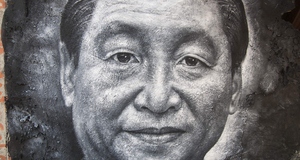Finding 'Love' in China: An Overview of Chinese Marriage Markets (BaiFaXiangQin)The Marital Selection Process in BaiFaXiangQinIn marriage markets, a complete matchmaking process is mainly made up of five steps: observations from afar, close-up observations, detailed discussions between parents, online dating, and meeting face-to-face. The first three steps are executed by the parents, relatives, or friends of the unmarried children. The last two steps involve the children of parents that conduct BaiFaXiangQin. Step 1: Observations From AfarIt is a common practice to meet the future in-laws. Many believe that the child is a reflection of the parents or parents' teachings. Thus parents generally observe other parents before deciding to proceed. Appearance provides the initial information and can shape the perceivers' ensuing behaviour (Efran, 1974; Todorov, Mandisodza, Goren, & Hall, 2005). Physical appearance can provide various information. Physical grooming such as clothes, hairstyle, and make-up affect whether these parents will take the next step in the marital selection process. Dynamic aspects related to nonverbal expressive behaviour such as posture, the way they converse, and their facial expressions (Riggio, Widaman, Tucker, & Salinas, 1991) will help parents determine their financial background, mannerisms, or their sincerity. Research has shown that personality traits can be linked to different physical appearances (Borkenau & Lieber, 1992).Parents are aware of the fact that they actively try to increase their standing by altering their appearance in certain patterns to shape a favourable impression of themselves or establish their position in a particular social class. Some parents in Marriage Markets are seen adorning expensive jewelry or wearing light make-up. This behaviour encourages more enquiries regarding their single children (Sun, 2012a). Several forms of static physical appearances such as dressing or hairstyles are ductile (Albright, Kenny, & Malloy, 1988). Expressive aspect of appearance (for example facial expressions or polite nodding) can also be easily influenced (DePaulo, 1992; Ekman and Friesen, 1974). Most of the parents conducting BaiFaXiangQin take advantage of this knowledge to be as strategically positioned for maximum respected attention (Sun, 2012a). Despite best efforts, it is difficult to manipulate other more subtle information like posture (Ekman & Friesen, 1974). It can be observed that the females pay more attention to their appearances compared to the males. This is due to gender norms where there is more emphasis on females to keep up their appearances as opposed to males (Naumann et al., 2009). Parents observe groups to scan for parents that fit their basic requirements before making the next move. Step 2: Close-Up ObservationsAfter observing groups from afar and shortlisting those that have acceptable appearance, parents will determine whether "yuan" exists between them and the other parent of an opposing sex before engaging in a detailed discussion. Chinese tend to associate the success of a relationship to a force called yuan (Chang & Chan, 2007; Goodwin & Findlay, 1997). Chang & Chan (2007) refer to yuan as the chief force that allows contextual factors to influence relationship development and processes. In order to understand the motivation for parents to observe the target in detail, one must understand the driving force behind it—yuan. According to Chang and Holt (1991), Chinese believe that yuan affects social and psychological interactions in social and romantic relationships. Relational development, or even the lack of it, are linked to yuan as it influences whether two individual are destined to cross paths. The absence of yuan is said to cause negativity to persist in a relationship or cause relationships to fail. Thus it is believed that their relationship is influenced by external forces rather than personal control (Chang & Chan, 2007). In East Asian culture, yuan is an important component in initiating, maintaining, and terminating the connection and relationship between two people. Yuan is a central factor in Japanese and Korean cultures (Kotajima, 1990, Ueno, 1987). Yang (1988) identified four aspects of yuan found in a Chinese community; yuan is popular in modern life as a staple key metaphor in decoding interpersonal relationships (Chang & Holt, 2002). First, yuan exists long before two individuals meet, even if the encounter is scheduled or ephemeral. Second, yuan dictates the development of the nascent stage of a relationship. When they have established a good first impression, both individuals are said to have yuan; this can also be attributed to the attraction that both parties may have for each other. On the contrary, if they don't feel like they have a predestined relation, then both parties do not have yuan fen. Third, Chinese use yuan as a self- and social-defence mechanism. It is common for people to attribute the failure or success of a relationship to yuan (Stander, Hsiung, & MacDermid, 2001). Explaining the condition of the relationship using yuan helps both parties to avoid using internal attribution, reduces the blame game, and highlights each other's negative behaviour as the source of the termination of the relationship. All these can lead to one losing face or reputation. As such, yuan is a widely accepted and an unquestionable excuse to illustrate the condition of one's relationship without resorting to unnecessary or uncomfortable details. Fourth, when one feels the presence of yuan, one would make more effort to develop the relationship, increase interaction, and cultivate an amiable environment. Relationship between the in-laws is crucial in Chinese communities. Thus, parents place a lot of importance on yuan with their target parent. This is a deciding factor for parents on whether or not to proceed to exchange details or to continue observing (Sun, 2012a). Step 3: Detailed Discussions Between ParentsParents will approach other parents and engage in a detailed discussion if step two reveals satisfactory results. Despite the commotion, the process is actually quite straightforward. According to Sun (2012a), there are four steps involved in Detailed Discussions. Parents will briefly exchange basic information about their unmarried children, exchange pictures of their unmarried children, discuss their personal prerequisite for mate selection, and exchange contact details. They will also analyse the way each other converse to pick up small details that they have yet to reveal verbally. To increase efficiency, some parents will put their single children's personal details on flyers and pass them out. Sun (2012b) likens the discussion to a double-sided sword. On one hand, Detailed Discussions can help parents to understand each other's single children and family condition, but it can also cause parents to accidentally reveal unflattering details about themselves and can be perceived as inappropriate and run the risk of losing face. If both parents are comfortable with each other or find their children to be compatible, they will convince their children to get to know each other online. This is a crucial step as this is the process where parents can obtain information to convey to their single children to convince them to meet their potential partner. The parents looking for spouses for their adult children often practice BaiFaXiangQin without the knowledge of their single children (Tully, 2013), so having the most attractive information about the potential partner can encourage the child to acknowledge BaiFaXiangQin. Step 4: Online DatingThe online dating step is where the single children are finally involved in the BaiFaXiangQin process. The potential partners are briefed by their parents about the qualities of the opposite sex and are encouraged to get to know each other online (Sun, 2012b). They usually prefer to make each others' acquaintance behind the safety of online platforms. The potential partners usually attempt to present themselves in a strategic and favourable light to make a good first impression. This fosters greater attraction and intimacy that would not have been as profound as potential partners that interact face-to-face without communicating online beforehand (McKenna, Green, & Gleason, 2002; Jiang, Bazarova, & Hancock, 2011). Online communication is distance-independent in terms of both use and cost. The potential partners might not be in close proximity, and conversing online is a natural, convenient solution (Boase & Wellman, 2004). Potential partners will be able to save on money during this introductory period when they opt to run it online and only invest on actual outings after confirming that both of them have chemistry. Due to the internet's asynchronous nature, the potential partners are not required to be online and engage in the communication process simultaneously (Boase & Wellman, 2004). This arrangement is less time-consuming and demands minimal commitment to maintain a relationship between the two individuals who are still uncertain about each other. The fast-paced nature of online interactions also inadvertently encourages intimate disclosures. The lack of a non-verbal element in online dating leads to people compensating by indulging in a more intimate interpersonal exchange (Reiss & Shaver, 1988). The potential partners are often anxious about embarking on the introductory phase. Online platforms help reduce anxiety in the sensitive nascent stage of the communication process. It also helps potential partners manoeuvre difficult conversations that are otherwise embarrassing or might cause them to lose face (Hertlein & Ancheta, 2014). Online Dating has a lower break-up cost. It is relatively easier to end the relationship online as opposed to a face-to-face situation (Boase & Wellman, 2004; Shun, 2012; Tong & Walther, 2011). Users can ignore messages, delete, and block contacts to avoid unnecessary confrontations, all at a minimal to non-existent cost. With the help of the Online Dating phase, the experience provides a different level of access to these potential partners and allows them to interact prior to deciding whether to form an offline relationship. Through online platforms, potential partners are able to save time and reduce emotional and financial investment. Ultimately, CMC (Computer Mediated Communication) is effective at helping potential partners to get an overview of their potential partners and to determine the compatibility between them (Finkel et al, 2012).Continued on Next Page » Suggested Reading from Inquiries Journal
Inquiries Journal provides undergraduate and graduate students around the world a platform for the wide dissemination of academic work over a range of core disciplines. Representing the work of students from hundreds of institutions around the globe, Inquiries Journal's large database of academic articles is completely free. Learn more | Blog | Submit Latest in Sociology |


















